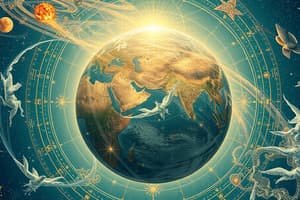Podcast
Questions and Answers
Which of the following best describes the characteristic of a mineral?
Which of the following best describes the characteristic of a mineral?
- It is solid and has a definite composition (correct)
- It can have a variable composition
- It can form only in living organisms
- It is a gas
What is the Earth's outermost system composed of?
What is the Earth's outermost system composed of?
- Solid ground
- Liquid water bodies
- Gaseous layers surrounding the planet (correct)
- Underground mineral deposits
Which of the following layers of the Earth's interior is liquid?
Which of the following layers of the Earth's interior is liquid?
- Inner core
- Mantle
- Crust
- Outer core (correct)
Which of the following is a connection between the atmosphere and lithosphere?
Which of the following is a connection between the atmosphere and lithosphere?
Which substance provides the fundamental medium for various life processes on Earth?
Which substance provides the fundamental medium for various life processes on Earth?
What do you call the process of rock breaking apart without changing its chemical composition?
What do you call the process of rock breaking apart without changing its chemical composition?
Which describes the processes by which sedimentary rock transforms into metamorphic rock?
Which describes the processes by which sedimentary rock transforms into metamorphic rock?
Which of the following defines the difference between mechanical and chemical weathering?
Which of the following defines the difference between mechanical and chemical weathering?
Quartz can break along planes of cleavage; what property of minerals does this illustrate?
Quartz can break along planes of cleavage; what property of minerals does this illustrate?
Which type of sedimentary rock is created through chemical precipitation?
Which type of sedimentary rock is created through chemical precipitation?
Flashcards are hidden until you start studying
Study Notes
Earth Science Concepts
- Solar System: Comprises the Sun and all celestial objects bound to it by gravity.
- Water: Essential substance on Earth that facilitates various life processes.
- Galaxy: A cluster containing billions of stars along with clusters of galaxies that form superclusters.
- Survival Requirement: All living organisms require water to survive.
- Earth's Interior: Predominantly solid with distinct layers, including a hot interior structure.
- Interaction of Systems: Animals and plants depend on the interaction of the geosphere and atmosphere for survival through water.
- Hydrosphere Components: Encompasses Earth's rocks, including crust, mantle, and core, classified into solid, liquid, and metal.
- Liquid Layer: The outer core of the Earth is in a liquid state.
- Mineral Characteristics: Minerals are classified as solid, inorganic substances with a definite chemical composition.
- Outermost Earth System: Atmosphere is considered the outer layer of Earth, encompassing gases surrounding the planet.
- Volcanic Eruptions: High silica magma can lead to explosive eruptions due to pressure build-up and slow lava flow.
- Mountain Formation: An example of the connection between the atmosphere and lithosphere is the formation of mountains.
- Sedimentary Rocks: Formed from sediments accumulated over time at ocean bottoms.
Atmospheric Science
- Ozone Layer: Part of the atmosphere that protects Earth from harmful ultraviolet (UV) radiation.
Geology Principles
- Mineral Cleavage: Quartz demonstrates planes of cleavage, showing the mineral's property related to fracture.
- Physical Weathering: Influenced by factors like ice, tree roots, and water; moss does not contribute significantly to this process.
- Rock Composition: Minerals are identified as the building blocks of rocks found in the geosphere.
- Weathering Types: Mechanical weathering contrasts chemical weathering primarily in its effect on rock composition.
- Streak Definition: A mineral's streak refers to the color of its powder when rubbed against a surface.
- Metamorphic Rock Formation: Sedimentary rocks transform into metamorphic rocks through intense heat and pressure.
- Mohs Scale: Used to measure the hardness of minerals.
- Physical Weathering Process: Rocks undergo breakdown without changing their chemical composition through physical weathering.
- Transformation of Rocks: Igneous rocks can become sedimentary rocks through weathering and erosion processes.
- Best Example of Physical Weathering: Expansion due to freezing and thawing causes rocks to crack.
- Sandstone Classification: Considered a type of sedimentary rock.
- Igneous Rock Formation: Resulting from the solidification of molten rock.
- Plutonic Rock Example: Granite is categorized as a plutonic rock.
- Erosion Agents: Wind, animals, and plants can all act as agents of erosion.
- Lithification Process: The method by which sediments compact under pressure to form solid rock.
- High Silica Eruptions: Eruptions can be violent under conditions of high silica content magma due to pressure builds.
Studying That Suits You
Use AI to generate personalized quizzes and flashcards to suit your learning preferences.




